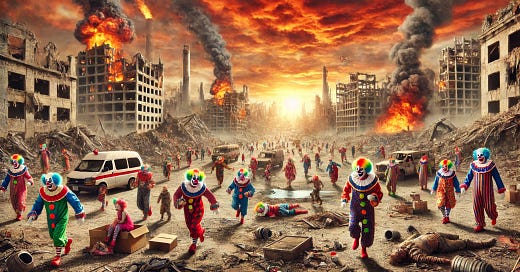On The Urge To Think Things Suck Worse Now Than Ever Before
And Scientific American’s ***COMPLICITY*** in spreading that foul meme
The other day I came across a Scientific American article headlined “We’ve Hit Peak Denial. Here’s Why We Can’t Turn Away From Reality.”
The article, by a pair of researchers at Stanford University and York University, attempts to argue that we are living in increasingly terrible, violent, chaotic times.
Is this true? It’s a widely held belief, particularly among academics and media, as well as an interesting horseshoe coalition of far-left (capitalism has destroyed everything) and far-right (multiculturalism and the collapse of traditional values have destroyed everything) thinkers and, perhaps more often, “thinkers.” Steven Pinker wrote The Better Angels of Our Nature: Why Violence Has Declined, published in 2011, in part to rebut this sort of thinking, which is endemic in his own circles.
So, the article: it’s bizarre. Let’s unpack it. The framing presents the thesis as an obvious, established fact, and immediately sets out to describe deniers as Part of the Problem and to explain their false beliefs. The subheadline: “We are living through a terrible time in humanity. Here’s why we tend to stick our heads in the sand and why we need to pull them out, fast.”
What is particularly terrible about these times? According to the authors:
If it seems like things are kind of off these days, you’re not alone. Recently, more than 100,000 people liked a post marking the start of the pandemic that said, “[Four] years ago, this week was the last normal week of our lives.”
Objectively speaking, we are living through a dumpster fire of a historical moment. Right now more than one million people are displaced and at risk of starvation in Gaza, as are millions more in Sudan. Wars are on the rise around the globe, and 2023 saw the most civilian casualties in almost 15 years.
These are all terrible events, and every one of the lives represented in these statistics is a real-life human person whose death or injury affected others. But at a zoomed-out level, none of this is remotely unusual in human history, and the authors don’t present any evidence — here or elsewhere in the piece — that things really are worse. “The most civilian casualties in almost 15 years” doesn’t mean much. It’s actually 13 years, according to the headline of the linked-to Guardian article. Let’s take a look at the top of that piece:
Action on Armed Violence (AOAV), a monitoring group, said 33,846 non-combatants had been killed or wounded during 2023, an increase of 62% on last year, and the largest amount it had counted since it began its annual survey in 2010.
Again: Every one of those is a real-life human. But still, the question at hand isn’t “Is it bad when people are killed or maimed in war?,” but “Are we seeing some sort of scary historical rise in the number of people killed or maimed in war?”
No. Not even close.
Keep reading with a 7-day free trial
Subscribe to Singal-Minded to keep reading this post and get 7 days of free access to the full post archives.


